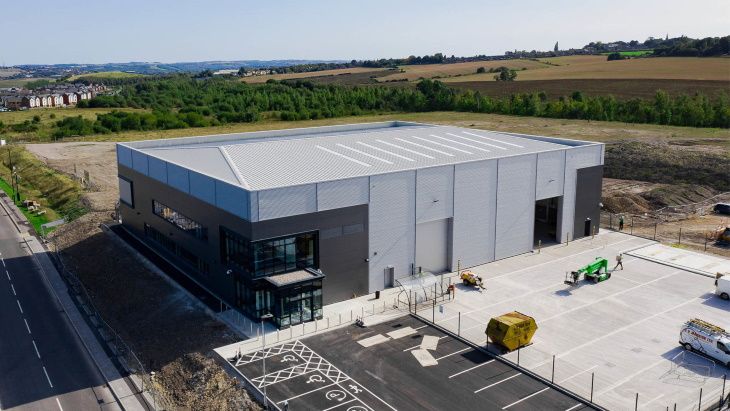The electric-car maker could benefit from improving profitability on vehicle sales and huge growth in its nascent energy business.



The US Army is developing augmented reality goggles for dogs to help protect their human guardians.
The BBC reports that the project, funded by the Small Business Innovation Research program, aims to allow soldiers to give dogs specific directional commands while they’re not in direct line of sight.
“Augmented reality works differently for dogs than for humans,” Stephen Lee, an Army Research Laboratory senior scientist, explained in a statement. “AR will be used to provide dogs with commands and cues; it’s not for the dog to interact with it like a human does.”


Harworth Group plc has announced the completion of the UK Atomic Energy Authority’s (UKAEA’s) new nuclear fusion technology research facility at the Advanced Manufacturing Park in Rotherham, South Yorkshire. When it opens later this year, the 2500-square-metre facility will develop and test joining technologies for fusion materials and components, including novel metals and ceramics.
Property developer Harworth said completion of the GBP22 million (USD28 million) Fusion Technology facility triggers UKAEA’s 20-year lease with Harworth at a rent in line with other manufacturers at the Advanced Manufacturing Park. UKAEA will now prepare the building prior to taking formal occupation of it later this year.
The new facility is being funded as part of the government’s Nuclear Sector Deal delivered through the Department for Business, Energy and Industrial Strategy. An additional GBP2 million of investment came from Sheffield City Region’s Local Growth Fund.

SkyWatch Space Applications, the Canadian startup whose EarthCache platform helps software developers embed geospatial data and imagery in applications, announced a partnership Oct. 5 with Picterra, a Swiss startup with a self-service platform to help customers autonomously extract information from aerial and satellite imagery.
“One of the things that has been very difficult to achieve is this ability to easily and affordably access satellite data in a way that is fast but also in a way in which you can derive the insights you need for your particular business,” James Slifierz, SkyWatch CEO told SpaceNews. “What if you can merge both the accessibility of this data with an ease of developing and applying intelligence to the data so that any company in the world could have the tools to derive insights?”
SkyWatch’s EarthCache platform is designed to ease access to aerial and satellite imagery. However, SkyWatch doesn’t provide data analysis.
Picterra is not a data provider. Instead, the company helps customers build their own machine-learning algorithms to detect things like building footprints in imagery customers either upload or find in Picterra’s library of open-source imagery.

 Paris, 4 October 2020. – A New York court has confirmed OneWeb’s rescue plan and put it back on track to launch its services in 2021, the London-based LEO operator announced.
Paris, 4 October 2020. – A New York court has confirmed OneWeb’s rescue plan and put it back on track to launch its services in 2021, the London-based LEO operator announced.
The U.S. Bankruptcy Court for the Southern District of New York confirmed OneWeb’s Chapter 11 reorganization plan, ensuring that the company remains on target to resume business operations and deploy the initial 650 LEO satellite constellation under its new ownership, OneWeb said.
“The transactions outlined in the Plan will be implemented following receipt of customary regulatory approvals, which are expected by the end of 2020. In the meantime, OneWeb is resuming operations and readying its commercial services which are planned to start next year.”

Microsoft’s Teams had a very busy September adding a host of new features. Now, the firm is looking to improve the performance of its Teams service as it continues in the battle to beat Zoom in the video conferencing space.
In an update detailing the features added in September, Microsoft explained how it was trying to improve Teams’ performance as a large proportion of the workforce continue to work from home.
Microsoft says it’s working to ensure businesses and schools “have a high-performance experience that scales across their devices and levels of internet connectivity.”

Latest wing testing and the evolution of our aerodynamic control at speed with the #JetSuit never stops at Gravity. Here with the awesome Benjamin Kenobi chasing with his Inspire drone🤘
LINKS
SHOP: http://www.gravity.co/mobile-shop/
Instagram: https://www.instagram.com/takeongravity/?hl=en
Facebook: http://www.facebook.com/takeongravity/
LinkedIn: https://www.linkedin.com/in/richardbrowninggravity/
Web: http://www.gravity.co
TED 2017 talk: http://go.ted.com/richardbrowning
BACKGROUND
With a rich family history in Aviation, former Oil Trader & Royal Marines Reservist, Richard Browning, founded pioneering Aeronautical Innovation company, Gravity Industries in March 2017 to launch human flight into an entirely new era.
The Gravity #JetSuit uses over 1000bhp of Jet Engine power combined with natural human balance to deliver the most intense and enthralling spectacle, often likened to the real life Ironman.
Gravity has to date been experienced by over a billion people globally and covered by virtually every media platform. The Gravity Team, based in the UK, have delivered over 100 flight & Speaking events across 30 countries including 5 TED talks.
“The team and I are delivering on the vision to build Gravity into a world class aeronautical engineering business, challenge perceived boundaries in human aviation, and inspire a generation to dare ask ‘what if…”

Space exploration may long have been the domain of national governments due to the huge budgets required. Investment from the private sector was slow to pick up due to uncertain economic returns and the concern that their involvement will in some way downplay the virtues of science. However, recent developments have seen increased participation by the private sector, ranging from partnerships with federal space programs to commercial space flights. As an investor, determine whether there is value to be unlocked from your support of space exploration activities, the feasibility of making a consistent return on investment and your capacity for risk.
You do not need to be a billionaire to invest in outer space. Several exchange-traded funds invest in aerospace companies likely to be involved in space exploration technology and related equipment. You can opt to buy stock in individual aerospace firms after diligent research to find firms that have the best track record. Investing in space ventures directly is too risky, and you have to be experienced and knowledgeable about the respective companies’ technology, management and business plans. In addition, their stocks are likely to plummet hard after setbacks or major disasters, so getting a diversified fund spreads the risk.
You can choose to invest your money in mutual funds with diversified holdings in aerospace companies. The mutual fund will be a collection of stocks, bonds and other securities. Your investment will yield money from dividends, distribution if the fund makes capital gains, or by selling your portfolio if the fund’s shares increase in price. Choose an investment that is low risk if you are new to the investment world or the space technology industry.